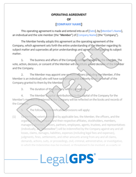Seller Bring-Down Certificates: What to Know Before Closing a Deal
Navigating the world of business transactions can, at times, feel overwhelming. When selling, one of the crucial documents you may come across is a ...
7 min read
LegalGPS : Jul. 25, 2024
Did you know that as a buyer in merger and acquisition negotiations, you have a certificate that helps you protect your interests? It's called a bring-down certificate. As legal concepts go, it's not as popular as your contract or lease agreements, but it is undoubtedly a crucial part of the deal.


Finalize Your Buyer Bring-Down Today!
Legal GPS templates are drafted by top startup attorneys and are fully customizable🛠️.
Trusted by 1000+ businesses to close secure deals.
A ‘Bring-Down Certificate’ or a ‘Bring-Down Letter’ is a legal document often used during the closing stages of an acquisition or merger. It is provided by the seller to the buyer and serves as confirmation that all the representations and warranties made in the purchase agreement hold true at the time of closing, just as they were at the time the purchase agreement was signed. This certificate essentially "brings down" the earlier representations and warranties to the closing date.
The Bring-Down Certificate serves two primary purposes - to provide assurance and minimize risk. The buyer wants a confirmation that there have been no breaches of representations and warranties before the transaction's final steps. To feel confident, you as a buyer will do well to have a bring-down certificate that 'brings down' the accuracy of representations to the present time.
If you ignore this important document, you risk losing your deposit and getting sued for any damages that may have occurred as a result of the breach. The Bring-Down Certificate is also important from a legal perspective because it allows buyers to sue sellers for breaches of warranty (such as misrepresentations) after closing. If the buyer does not receive this certificate prior to closing, they cannot sue the seller for any misrepresentations or broken promises made during negotiations.
A Bring-Down Certificate serves primarily to assure the buyer that the seller's representations and warranties are true on the closing date. It helps the buyer believe that there have been no breaches in the period from the signing of the purchase agreement to the transaction closing.
In other words, the certificate is a verification that the seller has not changed or misrepresented any of the facts that were part of the purchase agreement. If there are no changes or misrepresentations, then the seller cannot be held liable for any damages to the buyer. If there have been breaches in this time period, however, then they will be considered as “concealments” and can be used by buyers to void their warranties.
Bring-Down Certificates are mainly used in business transactions like mergers and acquisitions. It is not a standalone document but forms a part of the larger, more comprehensive purchase agreement. It is also used in real estate transactions when a seller wants to make sure that the buyer is not in arrears with any mortgage payments.
An expertly curated bring-down certificate can save you future headaches. Here's a step-by-step guide on how to prepare one.
The purchase and sale agreement is the foundation for your bring-down certificate. Therefore, the first step is to review the agreement carefully, focusing on the representations and warranties made by you (the seller). Understand which assertions you need to reaffirm in the certificate and make note of any specific dates or deadlines for updating or submitting the document.
Now that you're familiar with the representations and warranties from the purchase agreement, it's time to collect the information necessary to reaffirm them. This data may include:
Company financials, such as balance sheet, income statements, and cash flow statements
Compliance documents demonstrating adherence to all relevant laws and regulations
Contracts with third parties, like suppliers, clients, and partners
Litigation records, highlighting any ongoing or past legal disputes
Intellectual property documentation, like patents, trademarks, and copyrights
Employee management records, including employment agreements
Basically any information that would help to prove that the company has been operating as usual during the sale process.
Once you've gathered all the relevant data, verify its accuracy. Cross-check the documents with the leadership team, other key executives, and/or employees closely involved in the transaction process. The bring-down certificate will only hold weight if it is truthful and accurate. A few things you can do to verify the information include:
Interviewing key personnel: Interview the leadership team and other key executives to get a better idea of what's been happening with the company. You may also want to interview a few employees, especially those who are in charge of certain departments or tasks that are vital for operations.
Reviewing financial statements and reports: Make sure that all figures on financial documents add up; if not, this could be a sign that something is amiss with the bring-down certificate.


Legal GPS Pro
Protect your business with our complete legal subscription service, designed by top startup attorneys.
Now that you've compiled and verified the needed information, it's time to draft the certificate. Here's a simple format to follow:
Certificate Title: Clearly label it as "Bring-Down Certificate" followed by the Seller's name or company name.
Date of Submission: Indicate the date the certificate is prepared and submitted.
References to Agreement: Reference the purchase and sale agreement and its date.
Reaffirmed Representations and Warranties: List each representation and warranty, and explicitly state that each remains true and accurate as of the submission date. If required, provide updated information or documentation related to those representations and warranties. Remember, representations are statements of fact, while warranties are promises that certain conditions must be met. For example, if a building has no outstanding code violations and is in compliance with local zoning ordinances, then those are representations.
Acknowledgments: Include any acknowledgment by the company's leadership, such as acknowledgement of receipt of acquirer's consent in case of change of control or any other required approvals. This is important because it indicates that the company's leadership has been made aware of all the implications of the acquisition and are willing to go on record with their acknowledgement.
Signatures: Obtain signatures from authorized company representatives or officers, confirming the certificate's accuracy and completeness.
Make any necessary changes based on your legal counsel's review. Then, finalize the document, print it or save it as a PDF file, and submit it to the buyer. Ensure the buyer receives the bring-down certificate in a timely manner as specified by your purchase agreement or as otherwise agreed upon.
Get Your Buyer Bring-Down Certificate Template
with a Legal GPS Subscription
No one likes making mistakes, especially when it involves substantial financial investment and legal implications. Here are some common pitfalls sellers make and how you can avoid them:
Ensure your certificate captures all relevant information about your company's condition at the time of the agreement and at closing. Leaving out vital information can lead to legal issues and undermine trust with the buyer. A good example is the case of a buyer who bought a business that was in the middle of litigation. The seller failed to disclose this information, which led to costly legal issues for both parties.
The bring-down certificate is not a stand-alone document. Update it regularly to reflect any changes in the condition of the company. Failure to do so can lead to legal issues, particularly if the buyer finds that the company has deteriorated since closing. For example, if you neglect to update the bring-down certificate after selling off some of your assets or incurring debts, you could be held accountable for those obligations in the future.
Buyers can and will hold you accountable for any information that is not included in the bring-down certificate. For example, if you fail to disclose that there are outstanding lawsuits against your company, it will be on you if those plaintiffs decide to sue the buyer.
If you think this won’t happen, think again. Lawsuits are expensive and time-consuming, which is why buyers will often sue sellers for any information they think may have been misrepresented.
In fact, one of the most common reasons why buyers sue sellers is because they discover that there are outstanding lawsuits against the company. If you are sued by a buyer after selling your business, it’s likely that your insurance will not cover any damages.

Finalize Your Buyer Bring-Down Today!
Legal GPS templates are drafted by top startup attorneys and are fully customizable🛠️.
Trusted by 1000+ businesses to close secure deals.
Whether your business is headlong into a deal or foreseeing one soon, these expert tips can come in handy to create an effective Bring-Down certificate.
Maintain records of any significant developments that occur during the deal making process, and reflect them in your certificate where applicable. For example, if you have a signed letter of intent, make sure that it is included in your certificate. Similarly, if there are any changes or developments in the agreement, such as an increase in price or a reduction in services provided, they should also be reflected.
Update your certificate periodically to reflect accurate, current information about the company's condition. A common example is to update the certificate when a company is acquired by another company, or splits up into two parts. A more recent example is the Facebook initial public offering (IPO) in 2012, which caused many investors to reevaluate their investment strategies.
The Bring-Down Certificate should also contain a certification that the buyer has sufficient funds to complete the purchase, or that he is in possession of other adequate security for payment. If you are using a promissory note in lieu of cash, attach to the certificate a copy of the promissory note.
A Bring-Down Certificate (Buyer) is not merely additional paperwork during your business transaction but an essential document to protect your interests and ensure you are making an informed decision. For further assistance on drafting your Bring-Down Certificate, check out our comprehensive contract templates by clicking this link.
Remember, clarity is key in a Bring-Down Certificate, and there's no need to tackle this on your own. Legal counsel can guide you through the process and ensure you are well protected in your transaction. Happy buying!
Get Legal GPS's Buyer Bring-Down Certificate Template Now
The biggest question now is, "Do I need a business lawyer?” For most businesses and in most cases, you don't need a lawyer to start your business. Instead, many business owners rely on Legal GPS Pro to help with legal issues.
Legal GPS Pro is your All-In-One Legal Toolkit for Businesses. Developed by top startup attorneys, Pro gives you access to 100+ expertly crafted templates including operating agreements, NDAs, and service agreements, and an interactive platform. All designed to protect your company and set it up for lasting success.

Legal GPS Pro
Protect your business with our complete legal subscription service, designed by top startup attorneys.
| Premium Template Single-use Template |
Legal GPS Pro Unlimited Access, Best Value |
|
|
| Get Template | Learn More |
| Trusted by 1000+ businesses | |

Navigating the world of business transactions can, at times, feel overwhelming. When selling, one of the crucial documents you may come across is a ...

Navigating the complex world of legal documents and contracts can be intimidating, especially for business owners without a legal background. But it...

1 min read
Ever wondered what stock purchase agreements are, and why they're important for single business owners? Worry no more! In this friendly, informative...